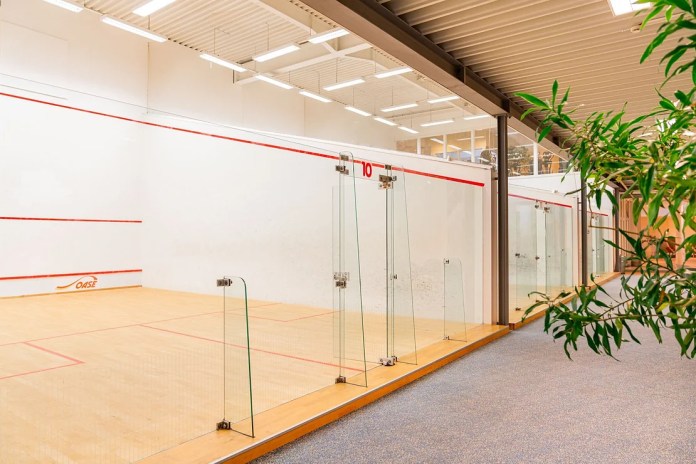Irishman Vincent Bradley (pictured above) has been head squash coach and part of the management team at OASE sports and fitness club in Bochum, western Germany, since it opened in 1975. He also runs a corporate health company, Fit Well, which is based at the club.
OASE is an award-winning commercial facility which had 25 courts in the early 1980s but now has six, plus six badminton courts, an extensive gym, sauna, swimming pool, physiotherapy, beauty services and more.
Having built up decades of knowledge on the squash and fitness industries in Ireland, Germany and the UK, Vincent knows a thing or two about the different business models used by squash facilities and formulas for success.
The non-profit, membership-based clubs that dominate in the UK contrast with the pay-and-play model which most facilities adopt in Germany, Poland and much of eastern Europe. Vincent believes a mixture of the two would serve squash well.
Recent figures from Sport England show that England has 250,000 adult squash players (who play at least twice a month) – down by an astonishing 175,000 since 2016. As shown in our 2024 Global Squash Report, the vast majority of England’s facilities are members’ and non-profit operations. In Germany, by contrast, 90% of squash facilities are commercially orientated.
“England has a high density of clubs, but they expect everyone to become members!” says Vincent. “Why not find a mixture between the German concept of pay and play, and the English version of membership and put them both together? Like everything in life, the mixture is the way to do it.
“A membership model can be good for connecting with people over the long-term and building a community, which is so crucial for a club’s success. But inclusion and accessibility is also important – giving as many people as possible the opportunity to play squash, including those who normally wouldn’t get the chance.
“We’ve missed the people in the middle – and we need to get to them. You’ve got to find the right mixture. I think the Squash Facilities Network through its case studies is doing a great job of defining what that mixture might look like.”
Vincent dismisses the notion that you can only build a thriving community through a membership model. He said: “I heard someone at the Squash Summit say that non-member facilities aren’t social because people come, play and go. That’s nonsense.

“Squash is growing as a commercial entity in eastern Europe and that’s because it’s an inherently social game. Squash is a brilliantly social sport, but the packaging around the sport has to match that brilliance. If the place looks good, you can get a shower, a sauna and a drink afterwards and it’s a place you and your family want to be, squash can build communities and be successful.”
But the most important part of the ‘packaging,’ says Vincent, is the personal touch which keeps people coming back. “It’s a people-to-people business,” he says. “If you put a slot machine in and ask people to check in and out, soon enough the facility will die. It’s so important to have employees who know your name, to bring people together and forge connections.”
The rise of padel – mostly in plush new high-spec facilities in metropolitan locations – reminds Vicent of squash’s late-70s and early 80s boom. He believes padel’s emergence must prompt squash to look at itself and ask some soul-searching questions.
“I see a lot of these members’ squash clubs in the UK and Ireland and ask myself if somebody’s daughter would go there and enjoy playing squash,” he says. “The experience around squash is so bad in lots of places. You’ve got no air conditioning, floors haven’t been cleaned, the hire rackets have disgusting old grips, there’s tight corridors and old, tired facilities. I ask myself, how is squash going to become popular with that sort of infrastructure?
“These days, when everything costs so much money, I don’t understand why people are prepared to accept and pay for that in their free time, and then wonder why other people don’t want to join?”
Squash’s core attributes – being a wonderful sport for fitness and socialising in which (uniquely) two opponents share the same playing space – gives Vincent hope that it can rediscover commercial success. At his OASE club in Bochum, he regularly sees young people taking advantage of its pay-and-play offer, coming off court sweaty and smiling with their friends and enjoying a sauna, swim, shower and a drink afterwards.
“We are a membership club, but a lot of people who discover the club come in through the pay-and-play system, then they see that it’s a very nice place to be and spend your time in. That’s because it’s a commercial club. I believe the traditional non-profit model is stunting the development of squash because you can’t earn any money, and if you don’t make money you can’t improve your facilities. Only with good facilities can you maximise squash’s brilliant qualities as a social sport.”

